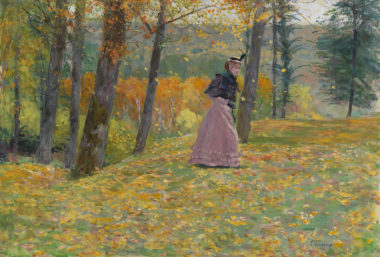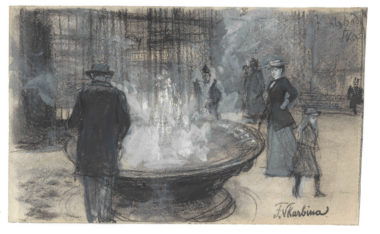Skarbina, Franz
Sold Artworks
Biography
Franz Skarbina
1849 – Berlin – 1910
The multifaceted oeuvre of the Berlin artist Franz Skarbina straddles the line between Berlin Realism and French Impressionism. Although Skarbina no longer enjoys the same degree of recognition for his work as Max Liebermann or Lesser Ury, he was nevertheless one of the leading artistic innovators working in Berlin at the turn of the twentieth century.
The experience of seeing, and then studying and making copies after Adolph Menzel’s monumental series of pen lithographs depicting Die Armee Friedrich des Großen in ihrer Uniform in the Berlin Prints and Drawings Collection in 1864 was a revelation for the fifteen-year-old goldsmith’s son Franz Skarbina. In the following year, he took up his studies at the Prussian Academy of Arts. In his early career, his drawing talents brought him numerous commissions for illustrations. He was noted for his attention to detail and skill in the portrayal of costumes and for his ability, in figure drawing, to capture the essence of natural and expressive poses. In 1881, he was appointed to teach anatomical drawing and proportion at the Art Institute of the Royal Arts and Crafts Museum in Berlin.
As a painter, Skarbina set out to find new forms of expression. He undertook study trips to Belgium, Holland and France in the 1880s and was receptive to progressive tendencies in contemporary art. Using free, impressionistic brushwork he captured atmospheric scenes of fashionable life in North Sea resorts and the distinctive feel of a windy, maritime climate. In other paintings he recorded the lives of ordinary people, employing a sombre palette to convey the bleakness of their surroundings.
Skarbina first visited Paris in 1882. The works of Edouard Manet, Auguste Renoir, Alfred Sisley and Berthe Morisot made a lasting impression on him. He was in Paris again from 1885 to 1886 and this productive period saw his transformation into a chronicler of urban life. He studied the flux of light and motion on the streets, squares and boulevards, and observed the bustle of people in busy cafes, clubs and restaurants or at theatres and variety shows. His delicately nuanced watercolours and gouaches, many of which feature elegant female figures, show how skilfully he exploited striking viewpoints and the shimmer of light to extract the poetry of the passing moment from everyday situations.
Skarbina returned to Berlin bringing fresh artistic impulses. In 1891, he completed work on a major painting titled Promenade in Karlsbad (Kunstamt Charlottenburg, Berlin). The painting combines a sober, realist approach to the motif with the lightness and immediacy of Impressionism. It is one of the most remarkable of all German Salon paintings. In 1892, he was co-founder of the Vereinigung der XI [Group of Eleven] with Ludwig von Hofmann, Walter Leistikow, Friedrich Stahl and seven other artists. With its elitist exhibition programme, the association quickly attracted public attention. It paved the way for the Berlin Secession but remained in existence until 1899. Skarbina was appointed as a member of the Prussian Academy in 1893. Towards the end of his life he was honoured with a special show at the Große Berliner Kunstausstellung – in those days the highest mark of recognition a painter working in the Prussian capital could be accorded.
PDF Download
